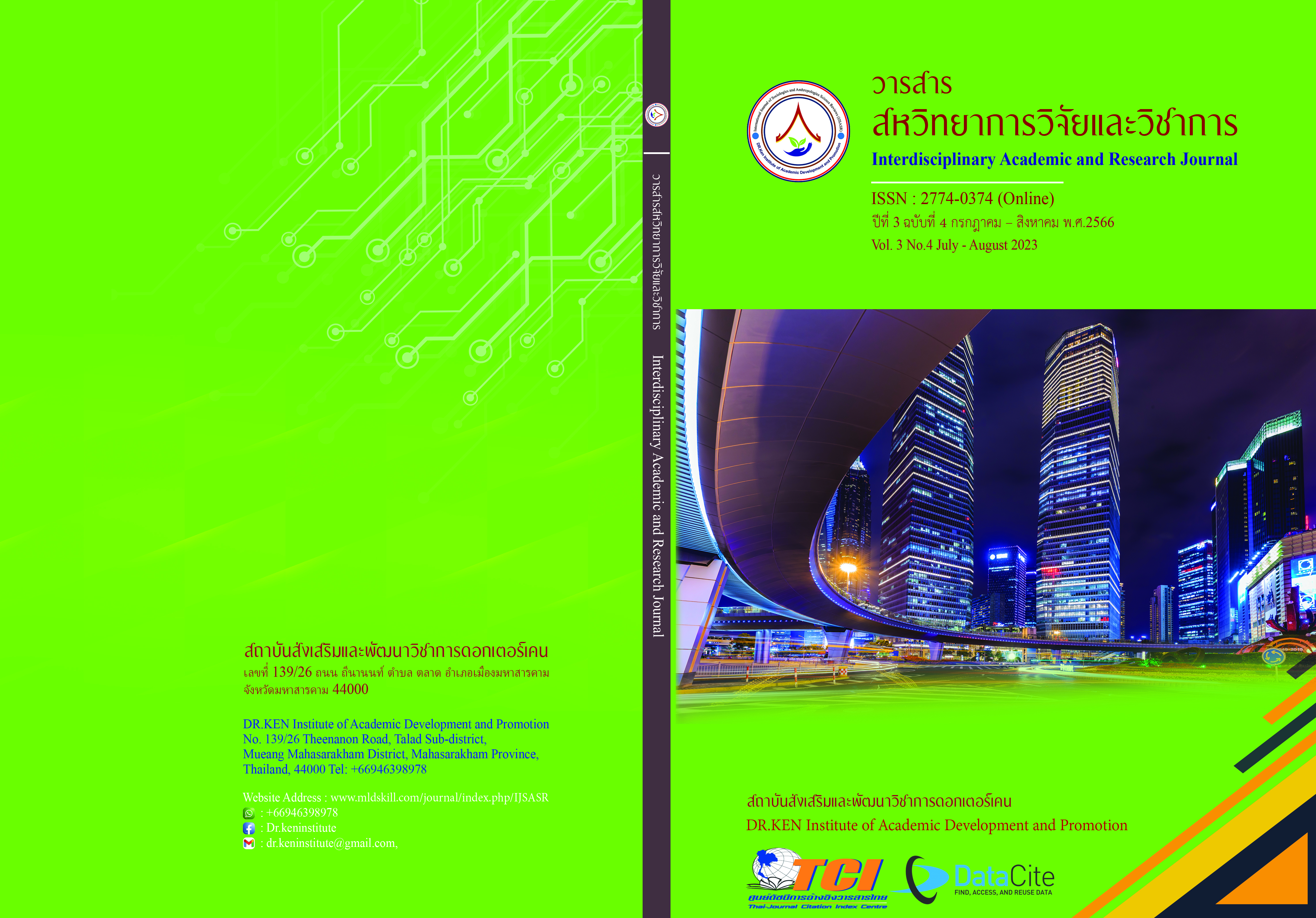Model to Information System Management on Educational Quality Assurance of Bureau Educational Testing, Office of Basic Education Commission
DOI:
https://doi.org/10.14456/iarj.2023.234Keywords:
Management Model; Information System; , Quality Assurance; , Basic EducationAbstract
The Ministry of Education has recognized the importance of educational information as information systems will help to support executive decision-making, each executive will make different decisions based on experience, knowledge, intelligence, way of thinking, and many other factors. Information is another important factor in supporting executives to make more efficient decisions. The objectives of this research were: (1) To study the conditions and guidelines for information system management for basic education quality assurance of the Bureau of Educational Testing. Office of the Basic Education Commission. (2) to create an information system management model for basic education quality assurance of the Bureau of Educational Testing Office of the Basic Education Commission. (3) to assess the model of information system management on educational quality assurance. Education Executives and school directors or teachers responsible for quality assurance, totaling 247 people in total, 12 informants. Tools used in the research. These were questionnaires, interview forms, and statistics used in the research were mean and standard deviation. and content analysis. The research findings were as follows: (1) Information system management for basic education quality assurance of the Bureau of Educational Testing. Office of the Basic Education Commission Overall, it was at a high level. and information system management guidelines for basic education quality assurance It corresponds to the elements of the 3-element model as follows: Component 1 Management consists of 1) Planning 2) Organization 3) Leading and 4) Controlling 2nd component Information system management consists of 1) data collection 2) data audit 3) data processing 4) data analysis 5) data utilization and 6) data warehousing. Component 3: Quality Cycle Management (PDCA) consists of 1) Planning (Plan) 2) Implementation (Do) 3) Check (Check) and 4) Correction (Act). (2) The Office of the Basic Education Commission found that the information system management model for basic education quality assurance of the Bureau of Educational Testing the Office of the Basic Education Commission consists of 4components: administration; information system administration. (3) Assessment of information system management model for basic education quality assurance of the Bureau of Educational Testing. Office of the Basic Education Commission Assessment Results Accuracy Appropriateness Possibility and overall usefulness were at a high level.
References
กระทรวงศึกษาธิการ. (2560). นโยบายปีงบประมาณ พ.ศ. 2560 สำนักงานคณะกรรมการการศึกษาขั้นพื้นฐาน. Retrieved on 20 December 2021 from: http://plan.bopp-obec.info/tmp/ upload/2016-04-01-09-26-53.pdf
กลุ่มยุทธศาสตร์และแผนการประชาสัมพันธ์ สำนักโฆษก. (2559). การประชุมคณะกรรมการเตรียมการด้านดิจิทัลเพื่อเศรษฐกิจดิจิทัลและสังคม ครั้งที่ 1/2559. Retrieved on December 20, 2021, from http://www.thaigov.go.th/index.php/government-th1/item/99971-id99971.htmV/th/government-th1.html.
ดาวประกาย ระโส. (2560). การพัฒนาระบบการจัดการสารสนเทศการประกันคุณภาพของสถานศึกษา สังกัดสำนักงานคณะกรรมการการศึกษาขั้นพื้นฐาน. วิทยานิพนธ์ปริญญาครุศาสตรอุตสาหกรรมดุษฎีบัณฑิต สาขาวิชาการบริหารการศึกษา. กรุงเทพฯ: สถาบันเทคโนโลยีพระจอมเกล้าเจ้าคุณทหารลาดกระบัง.
ธัญนรัตน์ โชติวิวุฒิพงศ์. (2559). การพัฒนารูปแบบการบริหารจัดการด้านสารสนเทศที่สอดคล้องกับบริบทในโรงเรียนระดับมัธยมศึกษา. วิทยานิพนธ์ปริญญาปรัชญาดุษฎีบัณฑิต สาขาวิชาการบริหารการศึกษา. กรุงเทพฯ: บัณฑิตวิทยาลัย มหาวิทยาลัยนอร์ทกรุงเทพ.
ภัคภิญญา ธรรมโชโต. (2560). รูปแบบการบริหารจัดการระบบสารสนเทศเพื่อสนับสนุนองค์การแห่งการเรียนรู้ตามเกณฑ์รางวัลคุณภาพแห่งชาติ. ปริญญานิพนธ์ปรัชญาการศึกษาดุษฎีบัณฑิต สาขาวิชาการบริหารและการจัดการศึกษา. กรุงเทพฯ: บัณฑิตวิทยาลัย มหาวิทยาลัยศรีนครินทรวิโรฒ.
ราณี จีนสุทธิ์. (2561). รูปแบบการบริหารจัดการระบบสารสนเทศเพื่อการให้บริการงานด้านวิชาชีพทางการศึกษา ของคุรุสภาที่สอดคล้องกับประเทศไทย 4.0. วิทยานิพนธ์ปริญญาปรัชญาดุษฎีบัณฑิต สาขาวิชาการบริหารการศึกษา. กรุงเทพฯ: บัณฑิตวิทยาลัย มหาวิทยาลัยนอร์ทกรุงเทพ.
วรรณศร ขอสกุลไพศาล (2561). การบริหารระบบสารสนเทศของโรงเรียน ในสังกัดสํานักงานเขตพื้นที่การศึกษาประถมศึกษาที่ผ่านการประเมินคุณภาพภายนอกรอบสามในระดับดีมาก. วารสารบัณฑิตศาส์น มหาวิทยาลัยมหามกุฏราชวิทยาลัย.16(1), 133-150.
วิโรจน์ สารรัตนะ. (2545). การบริหาร. พิมพ์ครั้งที่ 3. โรงพิมพ์ทิพยวิสุทธิ์.
วิลัยพร พิทักษา. (2561). รูปแบบการบริหารจัดการการใช้เทคโนโลยีสารสนเทศในสถานศึกษา สังกัดสำนักงานเขตพื้นที่การศึกษามัธยมศึกษา เขต 6. วิทยานิพนธ์ปริญญาปรัชญาดุษฎีบัณฑิต สาขาวิชาการบริหารการศึกษา. กรุงเทพฯ: บัณฑิตวิทยาลัยมหาวิทยาลัยนอร์ทกรุงเทพ.
สมยศ นาวีการ. (2525). การบริหารแบบมีส่วนร่วม. กรุงเทพฯ: มหาวิทยาลัยธรรมศาสตร์.
สัมมา รธนิธย์. (2560). หลัก ทฤษฎี และปฏิบัติ การบริหารการศึกษา. พิมพ์ครั้งที่ 4. กรุงเทพฯ: ส. เอเชียเพรส (1989) จำกัด
สำนักงานคณะกรรมการการประถมศึกษาแห่งชาติ. (2550). การประกันคุณภาพการศึกษา: การพัฒนาระบบข้อมูลสารสนเทศ. กรุงเทพฯ: โรงพิมพ์คุรุสภาลาดพร้าว.
สำนักงานเลขาธิการสภาการศึกษา. (2560). แผนการศึกษาแห่งชาติ พ.ศ. 2560-2579. กรุงเทพฯ : สำนักงานเลขาธิการสภาการศึกษา.
สำนักทดสอบทางการศึกษา. (2556). การจัดระบบบริหารและสารสนเทศภายในสถานศึกษา ตามกฎกระทรวงว่าด้วยระบบหลักเกณฑ์และวิธีการประกันคุณภาพการศึกษา พ.ศ. 2553. พิมพ์ครั้งที่ 2. กรุงเทพฯ: โรงพิมพ์ชุมนุมสหกรณ์การเกษตรแห่งประเทศไทย จำกัด.
เสกสรรค์ ทองศรี. (2557). การพัฒนารูปแบบการบริหารคุณภาพการศึกษาสําหรับสถานศึกษา สังกัดสํานักงานเขตพื้นที่การศึกษาประถมศึกษา. กรุงเทพมหานคร : มหาวิทยาลัยนอร์ททกรุงเทพ
Barnard, Chester I. (1938). The Functions of Executive. Cambridge: Harvard University Press.
Campbell, R.F., Gregg, R.T., & et al. (1957). Administration Behavior in Education. New York: Harper and Row.
Deming, E.W. (1994). The New Economics: for Industry, Government, Education. London: Cambridge.
Gulick, L.,& Urwick, L. (1937). Papers on the Science of Administration. Institute of Public Administration, New York.
Holt, M.D., & Thompson, J.D. (1998). Managing information technology in open and distance higher education. Distance education, 19(2), 197-227.
Husen, T., & Postlethwaite, N.T. (1994). The International Encyclopedia of Education. 7th edition, Great Britain: BPC Wheatons.
Keeves, J. P. (1997). Model and Model Building in the International Encyclopedia of Education. 2nd edition, Oxford: Pergamon Press.
Koontz, H., & O’ Denell, C. (1972). Principle of Management: An Analysis of Management Function. 5th edition, New York: McGraw-Hill.
Krejcie, R.V., & D.W. Morgan. (1970). Determining Sample Size for Research Activities. Educational and Psychological Measurement. 30(3), 607 – 610.
Laudon, K.C., & Laudon, J.P. (2009). Management Information System Organization and Technology in the Networked Enterprise. 6th edition, New Jersey: Prentice-Hall.
Likert, R. (1932). The Human Organization: Its Marketing and Value. New York: McGraw– Hill Book.
Madaus, G.F., Scriven, M.S., & Stufflebeam, D.L. (1983). Evaluation Models Viewpoints on Educational and Human Services Evaluation. 8th ed., Boston: Khuwer-Nijhoff Publishing.
Robbins, S. P. & Coulter, M. (2009). Management. Pearson International Edition. New Jersey: Prentice-Hall.
Schermerhorn, J.R. (1996). Management. USA: John Wiley and Sons. Inc.
Downloads
Published
How to Cite
Issue
Section
License
Copyright (c) 2023 Anongnart Inkongngam, Sowwanee Sikkhabandit , Panya Theerawitthayalert

This work is licensed under a Creative Commons Attribution-NonCommercial-NoDerivatives 4.0 International License.
Copyright on any article in the Interdisciplinary Academic and Research Journal is retained by the author(s) under the under the Creative Commons Attribution-NonCommercial-NoDerivatives 4.0 International License. Permission to use text, content, images, etc. of publication. Any user to read, download, copy, distribute, print, search, or link to the full texts of articles, crawl them for indexing, pass them as data to software, or use them for any other lawful purpose. But do not use it for commercial use or with the intent to benefit any business.
















.png)


